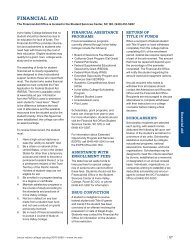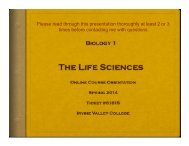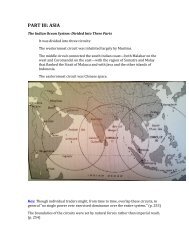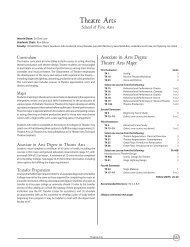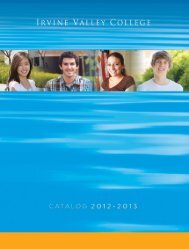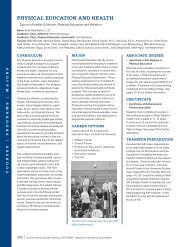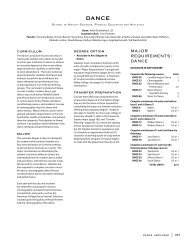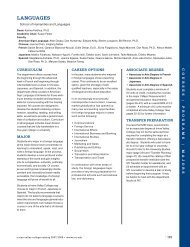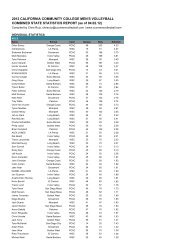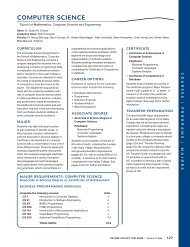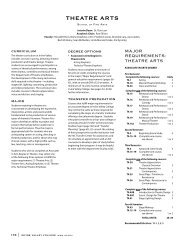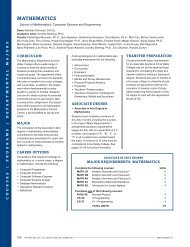mus - Irvine Valley College
mus - Irvine Valley College
mus - Irvine Valley College
Create successful ePaper yourself
Turn your PDF publications into a flip-book with our unique Google optimized e-Paper software.
C O U R S E S | P R O G R A M S | M A J O R S<br />
MUS 5: Harmony III<br />
5 Units<br />
5 hours lecture<br />
Transfers: CSU, UC<br />
Recommended Preparation: Mus. 4<br />
This course studies chromatic harmony<br />
elements (secondary functions, modulatory<br />
techniques, mode mixture, Neapolitan<br />
chords, augmented sixth chords, and<br />
enharmonic spellings). Students will study<br />
the application of these chromatic harmony<br />
elements in <strong>mus</strong>ical masterworks of<br />
the second half of the nineteenth century;<br />
analyze the usage of chromatic chords,<br />
their preparation and resolution; and create<br />
examples of chromatic writing. The<br />
course will include sight-singing and dictation<br />
of chromatic melodies; harmonic<br />
dictation in two-, three-, and four-part textures;<br />
rhythmic dictation; and keyboard<br />
harmony. This course is required for all<br />
<strong>mus</strong>ic majors. NR<br />
MUS 6: Harmony IV<br />
5 Units<br />
5 hours lecture<br />
Transfers: CSU, UC<br />
Recommended Preparation: Mus. 5<br />
This course studies harmony of the twentieth<br />
and twenty-first centuries focusing on<br />
the different techniques including ninth,<br />
eleventh, and thirteen chords; altered<br />
harmony; secundal and quartal harmony;<br />
polychord construction; twelve-tone<br />
system; minimalism; chance <strong>mus</strong>ic; and<br />
sound mass. Students are required to<br />
compose short <strong>mus</strong>ical fragments and<br />
complete presentations on twentieth century<br />
composers and their <strong>mus</strong>ic and/or<br />
compose pieces of <strong>mus</strong>ic involving one or<br />
more of these techniques. NR<br />
MUSIC APPRECIATION<br />
AND HISTORY<br />
MUS 20: Music Appreciation<br />
3 Units<br />
3 hours lecture<br />
Transfers: CSU, UC<br />
This course introduces skills for listening<br />
to <strong>mus</strong>ic, with an emphasis on the various<br />
Euro-Western classical <strong>mus</strong>ic traditions.<br />
Students will learn to identify components<br />
of <strong>mus</strong>ic such as meter, tempo, dynamics,<br />
texture, orchestration, and style characteristics.<br />
Students will also learn biographical<br />
information regarding significant<br />
composers, as well as the cultural, social,<br />
religious, and political contexts in which<br />
these traditions have existed and continue<br />
to exist. Students will also be provided<br />
with guidance in selecting concerts and<br />
recordings of the various <strong>mus</strong>ic traditions<br />
learned in the course. Attendance at live<br />
concerts is required. NR<br />
MUS 21: World Music<br />
3 Units<br />
3 hours lecture<br />
Transfers: CSU, UC<br />
This course introduces skills for listening<br />
to <strong>mus</strong>ic within both Western and<br />
non-Western <strong>mus</strong>ical traditions. Students<br />
study vocal and instrumental traditions,<br />
as well as <strong>mus</strong>ical components such as<br />
tempo, dynamics, texture, orchestration,<br />
form, and style characteristics. Students<br />
also consider historical, cultural, socioeconomic,<br />
religious, and/or political<br />
contexts and issues that bear upon the<br />
<strong>mus</strong>ic. Attendance at live concerts may be<br />
required. NR<br />
MUS 27: History of Jazz<br />
3 Units<br />
3 hours lecture<br />
Transfers: CSU, UC<br />
This course studies the development of<br />
<strong>mus</strong>ical styles, players, genres and forms<br />
of jazz. Emphasis is on styles, genres,<br />
forms, composers, and geographical<br />
centers of activity associated with jazz.<br />
Supplementary historical and biographical<br />
information will assist in placing the <strong>mus</strong>ic<br />
within the context of Western cultural and<br />
intellectual history. NR<br />
MUS 28: History of Rock Music<br />
3 Units<br />
3 hours lecture<br />
Transfers: CSU, UC<br />
This course traces the development and<br />
history of rock <strong>mus</strong>ic from the U.S. Civil<br />
War to the present. Students study <strong>mus</strong>ical,<br />
sociological and political aspects of rock<br />
<strong>mus</strong>ic as well as important people, ensembles,<br />
and institutions of the genre. The<br />
course includes a general study of <strong>mus</strong>ical<br />
elements such as melody, harmony, rhythm<br />
and orchestration as they pertain to the<br />
diverse styles of rock <strong>mus</strong>ic. Attendance at<br />
live concerts may be required. NR<br />
MUSIC<br />
(CHORAL PERFORMANCE)<br />
MUS 34: <strong>Irvine</strong> <strong>Valley</strong> <strong>College</strong><br />
Singers<br />
2 Units<br />
.5 hour lecture, 5.5 hours lab<br />
Transfers: CSU, UC<br />
Limitation: By audition only<br />
Recommended Preparation: Mus. 1<br />
The focus of the <strong>Irvine</strong> <strong>Valley</strong> <strong>College</strong><br />
Singers is on the rehearsal and performance<br />
of standard choral literature and<br />
world <strong>mus</strong>ic, including chant, traditional<br />
polyphonic and folk styles, in many languages.<br />
Students practice vocal techniques<br />
and ensemble singing. IVC Singers<br />
is open to all students by audition. Public<br />
performance is required for credit. R-E-3<br />
MUS 37: Women’s Chorus<br />
2 Units<br />
.5 hour lecture, 5.5 hours lab<br />
Transfers: CSU, UC<br />
Recommended Preparation: Mus. 1<br />
Limitation: By audition only<br />
The Women’s Chorus (“Oriana Choir”)<br />
focuses on the rehearsal and performance<br />
of choral <strong>mus</strong>ic for women’s voices from<br />
the sixteenth century to the present.<br />
Students practice vocal technique and<br />
ensemble singing. Public performance is<br />
required for credit. R-E-3<br />
MUS 38: <strong>Irvine</strong> Singers<br />
2 Units<br />
.5 hour lecture, 5.5 hours lab<br />
Transfers: CSU, UC<br />
Limitation: By audition only<br />
Recommended Preparation: Mus. 1,<br />
Mus. 39 or Mus. 80<br />
The <strong>Irvine</strong> Singers ensemble focuses on<br />
the study and performance of repertoire<br />
for chamber choir, both a cappella and<br />
with instrumental accompaniment. The<br />
ensemble performs concerts of choral repertoire<br />
for the smaller ensemble, from early<br />
polyphony to new <strong>mus</strong>ic by living composers.<br />
Entrance is by audition, and public<br />
performance is required for credit. R-E-3<br />
MUS 39: <strong>Irvine</strong> Masterworks<br />
Chorale<br />
2 Units<br />
.5 hour lecture, 5.5 hours lab<br />
Transfers: CSU, UC<br />
Limitation: By audition only<br />
Recommended Preparation: Mus. 1<br />
The Masterworks Chorale gives public<br />
concerts, often with orchestral accompaniment.<br />
The group offers singers a variety<br />
of experiences, including the opportunity<br />
to perform major works of the great composers,<br />
multicultural repertoire and new<br />
works. The focus of the repertoire varies<br />
each time the course is offered. Public<br />
performance is required for credit. R-E-3<br />
196 | irvine valley college catalog 2007/2008 • <strong>mus</strong>ic



